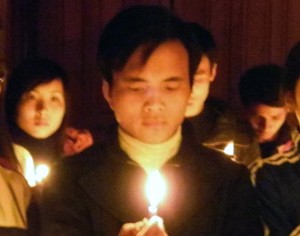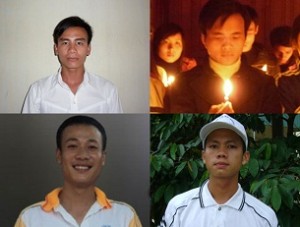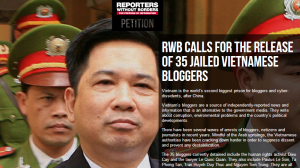Lacroix International, May 8, 2017
After three decades of growth in the novitiates of both male and female religious congregations in Vietnam, the number of young people attracted to consecrated life has dropped.
“A fall of nearly 50%!” exclaims Fr Pierre Van Huyen Tran, novice master for the Assumptionists in Vietnam.
“In congregations that ten years ago had around ten new candidates every year, now there are barely three,” he notes.
Similar observations can be heard in most male and female religious institutes in Vietnam.
“During the years following our first foundation here, in 1996, we had more than 20 aspirants each year with half from the city and half from the country,” explains Carmelite Etienne Le Thanh Tuu, leader of the Discalced Carmelites formation house in Ho Chi Minh City.
“Now, we only have ten per year, with 70% coming from the rural areas.”
“Since 1999, we have always had forty novices but this year there are only twelve, although there are four postulants and seven pre-postulants,” adds Sr Jean-Baptiste from the Congregation of the Benedictines of Vanves, who have been in Vietnam since 1954.
Following the political opening of the country at the end of the 1980s, a great number of congregations of European origin arrived in Vietnam to find communities.
This took place particularly in Ho Chi Minh City in the south of the country and at Vinh in the north, the two dioceses which boast the largest Catholic population.
“The missionary impulse that flourished in Vietnam will benefit the Church in other continents,” comments an European missionary who prefers to remain anonymous. Indeed, there are more than 200 congregations in Ho Chi Minh City alone, including 43 that are not officially registered with the government.
Over the last thirty years, many young Vietnamese from large Catholic families have enthusiastically embraced the religious life, particularly attracted by apostolic congregations and to a lesser extent by institutes of a contemplative life.
Now, however, all religious leaders have noted a decrease in the number of vocations, which they explain by the rapid economic development of the country. The drop in the number of children in each family and easier access to higher education also play a role, they say.
“Now, 80% of young Catholics take higher level studies whereas even ten years ago many of them, particularly from poor families, lacked the means to continue after high school,” explains Fr Duy Nguyen Khuong, finance officer, and teacher at the Assumptionist scholasticate in Ho Chi Minh City.
Globalization is another factor involved since it motivates young Vietnamese to leave for overseas. Some go to study, especially in China, North America, Europe or Japan, while others go to work, particularly in places such as Australia, South Korea, Taiwan, and Russia. In addition, many young women leave to marry Chinese and South Koreans.
“In my village of Quynh Than with 12,000 inhabitants, young people leave as soon as they turn eighteen,” sighs Fr Van Huyen Tran.
An additional reason for the decline can perhaps also be found in the “competition” between religious congregations themselves. Recently established congregations often attract more candidates than those that have been established for longer and which no longer systematically send their young people to study in the west.
Nevertheless, this numerical decline does not seem to unduly alarm the Vietnamese Church.
“It’s true our vocations are decreasing. However, our manner of recruiting is also slowly evolving. Our young people now join after three years of higher studies, and we appeal more to the freedom and maturity of candidates,” notes Sr Marie-Paulette Alaux, an oblate of the Assumption and novice mistress in Ho Chi Minh City.
In the training house that she manages, there are now two novices in their second year, three in their first year, as well as six postulants and twelve aspirants.
Height Insoles: Hi, I do believe this is an excellent site. I stumbledupon …
http://fishinglovers.net: Appreciate you sharing, great post.Thanks Again. Keep writi…
Achilles Pain causes: Every weekend i used to pay a quick visit this site, as i w…






May 9, 2017
Religious vocations are on the decline in Vietnam
by Nhan Quyen • [Human Rights]
Lacroix International, May 8, 2017
After three decades of growth in the novitiates of both male and female religious congregations in Vietnam, the number of young people attracted to consecrated life has dropped.
“A fall of nearly 50%!” exclaims Fr Pierre Van Huyen Tran, novice master for the Assumptionists in Vietnam.
“In congregations that ten years ago had around ten new candidates every year, now there are barely three,” he notes.
Similar observations can be heard in most male and female religious institutes in Vietnam.
“During the years following our first foundation here, in 1996, we had more than 20 aspirants each year with half from the city and half from the country,” explains Carmelite Etienne Le Thanh Tuu, leader of the Discalced Carmelites formation house in Ho Chi Minh City.
“Now, we only have ten per year, with 70% coming from the rural areas.”
“Since 1999, we have always had forty novices but this year there are only twelve, although there are four postulants and seven pre-postulants,” adds Sr Jean-Baptiste from the Congregation of the Benedictines of Vanves, who have been in Vietnam since 1954.
Following the political opening of the country at the end of the 1980s, a great number of congregations of European origin arrived in Vietnam to find communities.
This took place particularly in Ho Chi Minh City in the south of the country and at Vinh in the north, the two dioceses which boast the largest Catholic population.
“The missionary impulse that flourished in Vietnam will benefit the Church in other continents,” comments an European missionary who prefers to remain anonymous. Indeed, there are more than 200 congregations in Ho Chi Minh City alone, including 43 that are not officially registered with the government.
Over the last thirty years, many young Vietnamese from large Catholic families have enthusiastically embraced the religious life, particularly attracted by apostolic congregations and to a lesser extent by institutes of a contemplative life.
Now, however, all religious leaders have noted a decrease in the number of vocations, which they explain by the rapid economic development of the country. The drop in the number of children in each family and easier access to higher education also play a role, they say.
“Now, 80% of young Catholics take higher level studies whereas even ten years ago many of them, particularly from poor families, lacked the means to continue after high school,” explains Fr Duy Nguyen Khuong, finance officer, and teacher at the Assumptionist scholasticate in Ho Chi Minh City.
Globalization is another factor involved since it motivates young Vietnamese to leave for overseas. Some go to study, especially in China, North America, Europe or Japan, while others go to work, particularly in places such as Australia, South Korea, Taiwan, and Russia. In addition, many young women leave to marry Chinese and South Koreans.
“In my village of Quynh Than with 12,000 inhabitants, young people leave as soon as they turn eighteen,” sighs Fr Van Huyen Tran.
An additional reason for the decline can perhaps also be found in the “competition” between religious congregations themselves. Recently established congregations often attract more candidates than those that have been established for longer and which no longer systematically send their young people to study in the west.
Nevertheless, this numerical decline does not seem to unduly alarm the Vietnamese Church.
“It’s true our vocations are decreasing. However, our manner of recruiting is also slowly evolving. Our young people now join after three years of higher studies, and we appeal more to the freedom and maturity of candidates,” notes Sr Marie-Paulette Alaux, an oblate of the Assumption and novice mistress in Ho Chi Minh City.
In the training house that she manages, there are now two novices in their second year, three in their first year, as well as six postulants and twelve aspirants.